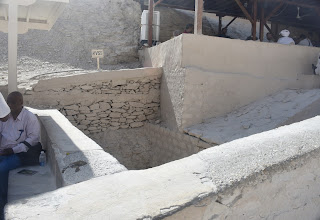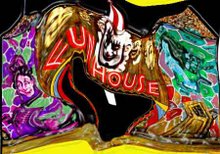Today would be a very exciting day! We had to have early breakfast because we would depart at 8:00 AM. This meant we did get to see the balloons rising over the Valley of the Kings because we were up early enough to do so.

You can see the burners lighting up the balloon bottoms in the shot below.

I ordered off the menu for a change and had eggs Benedict with smoked salmon.

We were in a festive mood...

but we still needed our morning coffee.

The staff was extremely attentive and hard working (as always).
On the bus we rode again along the Nile.

On the bus ride we saw lots of fields and donkeys and carts loaded with sugar cane.

We also got to see workers bringing the balloon baskets back from the fields where they landed.

It is a very pretty countryside within the fertile zone of irrigation. There were villages here and there and we caught a small glimpse of village life in the morning.

I think I want to print a series of photos on Egyptian village life. Maybe I can find a gallery that would be interested in them.


I guess this balloon was a late bloomer!

We also rode through less hospitable territory where there were all kinds of buildings crumbling into the desert.

As we got close to the archaeological site it was even more the case since they have had to move people out of their homes in order to excavate.



This site was used as a photo op and all the buses stopped at a platform that allowed people to take their pictures with the full statues in the background.

We passed all kinds of interesting buildings and ruins.


I have no idea what any of these are.


As we got closer, we saw just rocks and sand.
Eventually though we arrived at the parking area. Of course there was a market there so we could buy our souvenirs.

But at the end of the market, there was a little map of the area so we could see where all the tombs are.

...and then they loaded us into little carts and took us to the Valley of the Kings.
Some of the drivers wanted to hot rod it past others (I think they were a little bored and had to invent games with each other.)
But eventually we got to the site itself which is a sprawling wasteland with no real buildings, because all the interesting history is under ground. With no trees or shade, the place is quite hot (yeah, great idea - let's go in the middle of summer because there will be fewer tourists!) ...and of course there is still a lot of walking to be done because they set you down on a wide avenue that goes on for what seems like miles. (And actually I do recommend late Summer for visiting because there ARE fewer tourists and the heat is not that oppressive.)
There are little square holes with gratings over them everywhere and each one leads to a tomb of a noble person or king.
Many of the tombs were looted and found empty, but diligence and persistence led to some very helpful discoveries and of course Howard Carter found Tutankhamun's tomb in 1922 and it was full of magnificent personal objects, chariots, boats, thrones, jewelry and funerary items (see the post on the Egyptian Museum). We started with KV62 the tomb of Tutankhamun because uncharacteristically there was no line when we arrived and we could get in quickly. On our way, we passed by tombs of many famous kings.


They rotate which tombs they open to the public to minimize the damage caused by human breath and presence.
I would've so loved to see any of these other tombs.
And then, there it was: the famous KV62.
This was not the tomb that Tutankhamen was supposed to be buried in, but he died suddenly and his royal tomb was not ready, so they evidently had to make do with a tomb originally built for someone else.
The lay out of the tomb is very simple compared to others we would see.
As you can discern from the diagram from Wikipedia, it consists of four basic chambers entered through a long corridor.After proceeding down the staircase and through the corridor, one enters the antechamber where 4 large chariots were found along with two life-sized wooden guardian figures. I believe the body of King Tut now rests in the antechamber. Only the burial chamber itself has images on the walls. When Howard Carter originally discovered the body they had to disassemble it to get it out, which proved very tricky because the unguents used to preserve the body had solidified underneath the body. The body itself was not in good condition.

There were many theories about Tutankhamon's death many based on the condition of the body. He was young and they estimate he only ruled 9 or so years. One theory based on damage to the skull, that Tut was killed by being hit over the head, was shown to be wrong when the bone fragments were shown to be thoracic parts that had been dislocated during some of the many examinations. Carter had the body placed back in the tomb on a bed of sand where it now remains.
Because it is so narrow and dim, it is hard to get a good shot of the burial chamber paintings. Below we see depicted Tutankhamen preparing for the mouth opening ceremony.
The rest of the mural shows the dead man getting the goddess Mut (in the center) and embracing Osiris (with his Ka (soul)) behind him on the left.
I really love the baboons on the west wall.
Editorfrommars has a better version from Wikipedia.
Experts believe the tomb had been robbed twice, shortly after it had been used. The second set of thieves probably got away with some 60% of the jewelry that had been there. They know this because the contents were carefully labelled. A collection of rings found tied in a handkerchief may have been dropped when thieves were interrupted in their actions. It was the practice to deposit the rubble from the preparation of a royal tomb by the entrance and speculation is that an avalanche of detritus and sand from the temple of Ramses VI fell over the entrance and probably protected the tomb from being further looted over all the coming centuries.
















































No comments:
Post a Comment